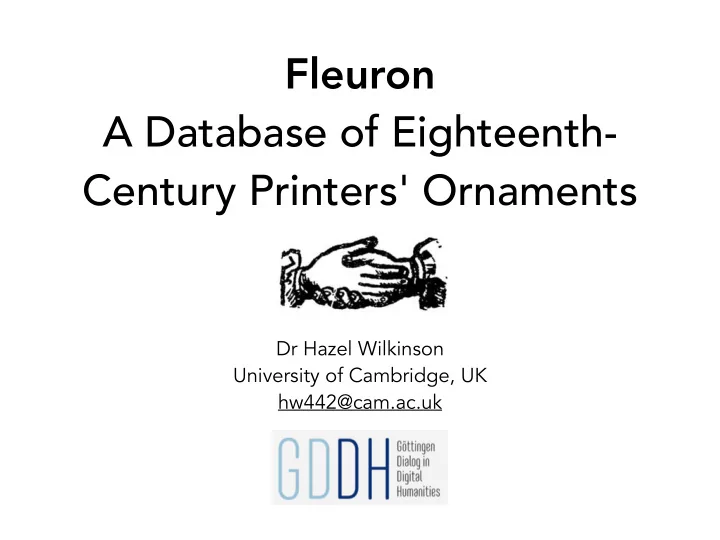

Fleuron A Database of Eighteenth- Century Printers' Ornaments Dr Hazel Wilkinson University of Cambridge, UK hw442@cam.ac.uk
The Fleuron Team Filippo Spiga Hazel Wilkinson Research Software Engineer Principal Investigator Dirk Gorissen James Briggs Software Engineer & Computer Research Software Engineer Vision Expert & Web Developer
Hand Press Printing c .1440–1830
Woodcut printing
Fleurons
Woodcut printing
Eighteenth-Century Collections Online ( ECCO ) 1700–1800 • 136,291 titles • 155,010 volumes • More than 32 million pages Early English Books Online ( EEBO ) 1473–1700 • 125,000 titles
- Preprocessing: Clean up the image conservatively, removing small noise but trying not to distort things - The image is thresholded to black/white such that all white pixels are a 1 and all black pixels are 0 - Apply a series of open & closing morphological operators in order to remove small (white) speckles and close small (black) holes. - The contours of the image are found and all closed, isolated contours with a bounding box area of less than 50 pixels are removed Dirk Gorissen, Machine Doing Ltd www.dirkgorissen.com
- Do a rough estimate of what are just lines of text are remove them - Heavily dilate the image, think of it as blurring the images, or increasing the thickness of all white lines. This will cause ornaments that are made out of many different small separate elements to be joined together as a whole. Note this has as side effect that the letters in the text will be glued together as well. Something we have to deal with later. - Again remove small, negligible contours Dirk Gorissen, Machine Doing Ltd www.dirkgorissen.com
- Loop over all remaining contours and decide for each one whether it is an actual ornament, a full page illustration, a blob of glued together text, or something else. This decision is made based on a set of heuristics. We know ornaments do not occur randomly. They are often centred with the text in the page, if not centred the occur in specific places (e.g., capital letters), they have specific aspect ratios (e.g., dividers), if they are made up of little pieces the size distribution of those little pieces is different than the size distribution of a line of text, etc. - So as we loop through we classify things as ornament, not an ornament, or not sure. If we are not sure we try to break it up into little pieces (by looking at the original image again (vs the dilated one)), and run some tests to see if it actually isn’t some glued together text after all. If we still cant figure it out, err on the safe side and treat it as an ornament. - Finally, for each ornament, find the bounding box, extract it from the image, save separately, and write the json file. Dirk Gorissen, Machine Doing Ltd www.dirkgorissen.com
High Performance Computing (HPC), at the University of Cambridge Research Software Engineering (RSE), University Information Services
"There are approximately 150,000 books in the entire catalogue. On a high end Intel workstation it takes on average about 6 hours to extract all the ornaments of just 50 books using Fleuron. This means that it would take over 2 years to process the entire catalogue if we were to only use the workstation! For a problem of this size, an HPC cluster is the only tool that can get the job done in a reasonable amount of time. The books have been arranged into batches of 50 and each one of these batches is run on a single node of Darwin, the HPC cluster at the University of Cambridge. Assuming a job time of 6 hours per batch, if 50 nodes are used then the entire catalog could be processed in 15 days. In practice, the cluster is shared with many other users so the actual expected time of completion will be approximately 4-5 weeks.” ––James Briggs, Research Software Engineer, University of Cambridge, UK
“After the data has been extracted, a labeled dataset ~1000 images will be produced from a random subset of the images. The images will be labeled as either 'valid' or 'invalid'. One this has been produced we can then go about training different machine learning algorithms to automatically classify the images as 'valid' or 'invalid'. After this model has been trained and tested to have sufficient accuracy, we can then apply it to the entire dataset.” –––James Briggs, Research Software Engineer, University of Cambridge
New Directions in Technology: •Image searching •User contribution •Integration of/with other databases
New Directions in Research: •Printer identification •Statistical analysis •History of graphic design and art
Fleuron was developed with sponsorship and assistance from:
Recommend
More recommend